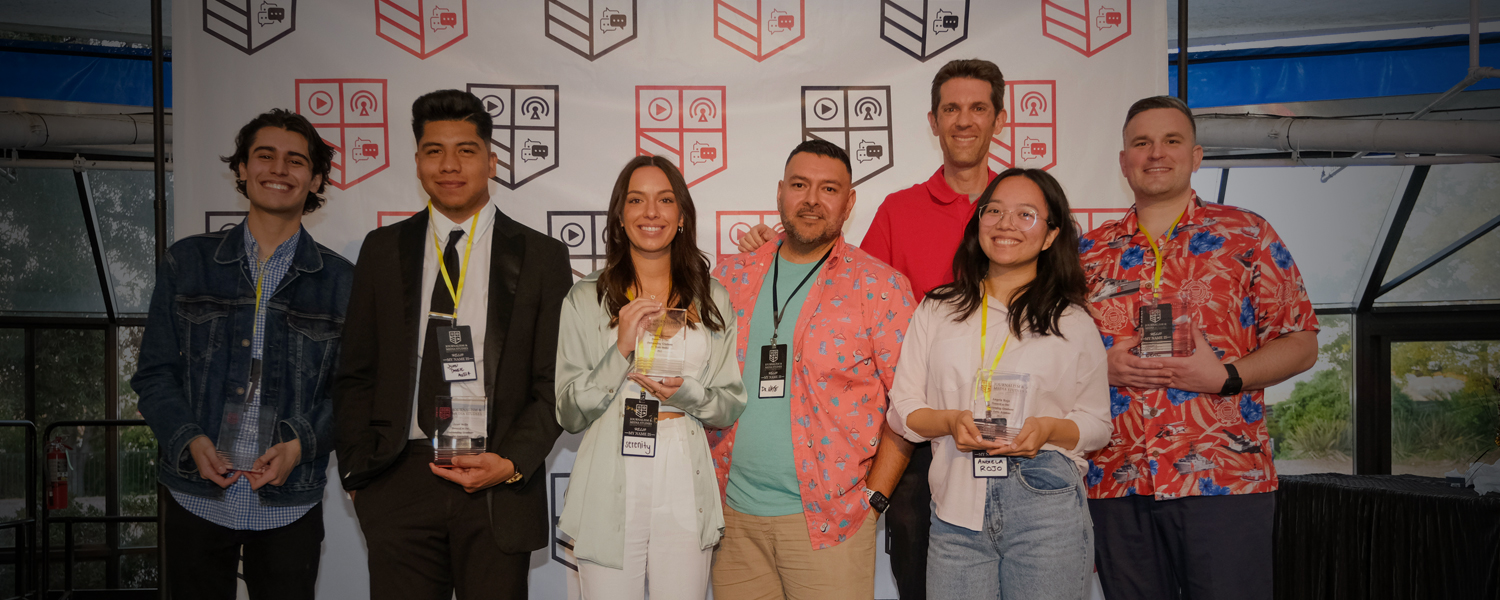Student Media
The School of Journalism and Media Studies is home to two independent student-run media organizations: The Daily Aztec (print and online newspaper) and KCR Radio (radio station). Together, they form a core opportunity for JMS students to gain practical experience while also providing an important service to the SDSU community. Opportunities to get involved in student media are open to all students, regardless of major, although JMS students are particularly encouraged as an integral part of their training.
Student Media
In Fall 1913, the student body of the San Diego Normal School voted affirmatively to begin publishing a campus newspaper. On Nov. 26, 1913, as a four-page tabloid, the first edition of the Normal News Weekly was published. On the front page, the following announcement appeared:
“You voted for the establishment and maintenance of a school paper. It is now up to every one of you, individually, to meet this responsibility. You know the paper cannot subsist on San Diego climate and fricasseed air. Our advertisers pay good, hard coin for the “privilege” of supporting this publication, but they, in turn, must get returns on this expenditure.
As soon as you have read over this article, read over the advertisements: the next step is to patronize these advertisers and tell them you are from the Normal School. We want the “Normal News,” but we can’t have it unless you see that our advertisers get returns for their money.”
The Normal News survived until 1921 when it was replaced by the Paper Lantern. The first editor, J.C. Almy Harding, was responsible for both the campus newspaper and yearbook, Del Sudoeste. He noted that,
“President Hardy gave us the best gifts an editor can ask — a free rein both editorially and financially. He offered no advice, guaranteed no subsidy, and reminded us we would be accountable for any journalistic misdeeds.”
The Paper Lantern discontinued the tabloid tradition by moving to a standard size, seven-column news format. Then, in 1925, the students voted to change their official nickname to “The Aztec.” Reluctantly, the Paper Lantern bowed to this new banner.
During World War II, The Aztec, still a four-page weekly, also published a newsletter for students in the armed services.
The next milestone in the newspaper’s history came in 1959, when The Aztec’s staff proposed publishing on a daily basis. The idea initially was not well received. Most members of the Publication Authority Board did not think there was enough campus news, student interest or money to support a daily newspaper at San Diego State College. In 1960, the Aztec became daily, thus The Daily Aztec.
During its adolescence, from 1925 to 1973, The Daily Aztec was heavily subsidized by the University and Associated Students. It was regularly advised and, in some measure, directed by a Faculty Advisor who was connected with the journalism department. The Associated Students Council approved the budget and all the expenditures for the newspaper. It also appointed the student editor, but not without the approval of the university president. Students who worked on the paper were required to turn in carbon copies of their articles to the faculty advisor, who, in turn, taught the journalism class titled, “Newspaper Production.” The articles were graded and returned to the students who wrote them.
Tensions from these complicated and overlapping relationships prompted University President Brage Golding in 1973 to appoint a Blue Ribbon Commission on The Daily Aztec. The commission evaluated the newspaper’s governing structure and recommended a radical departure from previous arrangements. The commission felt strongly that The Daily Aztec should not serve the campus in two conflicting capacities — as a laboratory tool of the journalism department and as a student publication providing campus news and editorial comment. The commission also argued for greater autonomy for the newspaper — autonomy from the Associated Students Council and the University administration. They did not achieve this goal. But The Daily Aztec did sever its formal connection to the journalism department as a result of this study. And, the idea of a campus-wide policy board, a Publications Authority, serving as publisher of The Daily Aztec was proposed and implemented a year later.
The centennial publication of The Daily Aztec reflects a new century of journalism with the launch of the Spanish version, Mundo Azteca, and the launch of an official app.
In an effort to best serve the SDSU community, The Daily Aztec transitioned to a semi-weekly print publication in 2013. The Daily Aztec then focused on increasing its presence in the online and mobile platforms the students, faculty and staff of SDSU were relying on for their news, entertainment and information.
In Spring 2020, due to the onset of the COVID-19 pandemic and subsequent closure of campus, The Daily Aztec transitioned to an online-only format and continues to deliver students, faculty, staff and SDSU community members quality journalism.
KCR is San Diego State University’s premiere college radio station.
It is a student-run station that broadcasts live online for the SDSU and greater San Diego community. Students can express themselves freely, and audiences get to experience the independence and creativity of a college radio station.
All shows are hosted by current SDSU students, as well as some awesome alumni. It covers music, news, and sports. If a student isn’t broadcasting live, listen in to discover new music on our eclectic mix, filled with curated songs from up and coming bands. KCR is your source for great entertainment streaming live at all times!
KCR has been in continuous operation since 1969. Original broadcasts took place over cable systems, and now we broadcast live on local digital cable channels, online, and on the TuneIn radio app.
KCR Mission Statement:
(1) to give SDSU’s aspiring DJs, newscasters, sports broadcasters, radio personalities and other radio station personnel an opportunity to learn and hone their skills; and
(2) to serve the university and the San Diego community through diverse, compelling content, including music, news, sports, entertainment and coverage of SDSU events.

